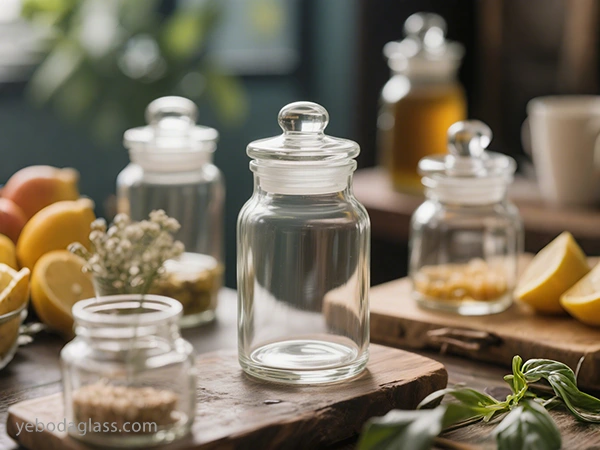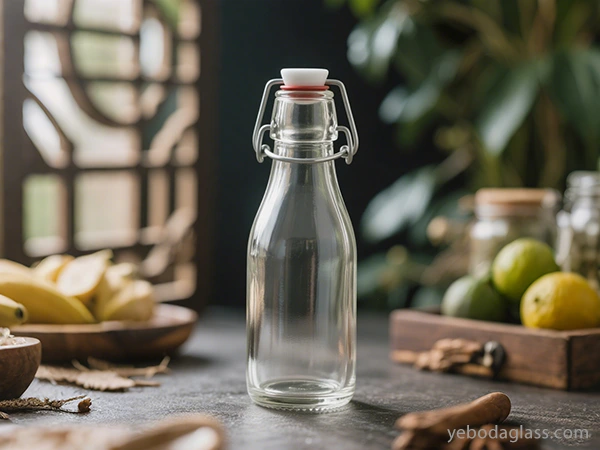Introduktion
Straight cutting:

For making cups, vases, and storage jars, you can use the scratch heat stress method (rope flame method, hot water/ice water method, manual cutter) or wet tile saw.
Curves and complex shapes:
For making special-shaped vases and lampshades, you can use diamond-coated rotary tools (such as Dremel), professional glass saws, water jets, or laser cutting.
Removing the bottom of a bottle:
For making candlesticks and open containers, you can use the scratch heat stress method, wet tile saws, or professional glass saws.
- Cut smoothness Rough edge:
- Only cut, no treatment. Simple treatment:
- Slightly grind to remove sharp edges to ensure safety. Grind edge:
Use diamond grinding wheel to treat, create a satin or matte effect.
- Polish edge:
- Polish on the basis of grinding to achieve a bright effect.
Bevel edge:
- Snit: Miter edge:
- Cut at a specific angle to facilitate the connection of two pieces of glass. Tools and equipment
- Hand tools: glass cutters, manual cutters, suitable for small-scale DIY, low cost.
Power tools:
Dremel rotary tools, wet tile saws, more efficient and accurate, suitable for medium-sized projects.
Industrial equipment:
- CNC cutters, laser cutters, water jet cutters, suitable fhigh-precision, high-volume, complex-shaped industrial production. Understand the characteristics of glass
- Different glass bottles have different “tempers”! For example, thicker bottles (those over 6 mm) need to be cut more carefully; if the bottle is annealed (many ordinary glass bottles are annealed to make the glass more stable), it will be easier to cut than untreated ones and will not crack easily. But we are playing at home, so we don’t need to go into details. Just remember “slow operation for thick bottles and steady operation for thin bottles”~ Super practical cutting method
- Scratch thermal stress method scratch a line on the glass, and then use the temperature difference between hot and cold to make it crack along the scratch
Steps:
- Find a glass cutter, and steadily draw a continuous line along the place where you want to cut the bottle. Prepare a basin of hot water (about 40-43℃, it feels a little hot but acceptable) and a basin of ice water. First, soak the scratched part of the bottle in hot water and shake it, then immediately take it out and throw it into ice water! Once the temperature difference is stimulated, “pop” – the bottle may crack along the scratch! If it doesn’t crack, repeat the hot and cold cycle several times, don’t worry~ Applicable:
- If you want to cut the bottle into a straight tube (such as a water cup or vase), it is suitable for beginners to play with small batches, and the cost is almost zero! The cut may not be very smooth, and you have to polish it later; you have to try a few more times to get a feel for it. The type and thickness of glass will affect the effect. For example, a very thick bottle may not crack.
- Abrasive mechanical cutting Use a tool with abrasives to “grind” off the glass, which can cut out complex shapes and is more accurate than the pure scratch method.
- Tools & Steps: I have a Dremel small electric grinder at home, equipped with a diamond-coated grinding head. Turn on the electric grinder, slowly grind along the line you want to cut, rinse with water while grinding (don’t let the glass overheat and crack), grind out a groove until the bottle cracks or wears through. If you want to cut straight lines, it is more convenient to use a wet tile saw. Add water to cool it, and push the bottle to cut slowly, just like cutting vegetables~
- If you want to cut curves (such as making special-shaped decorative bottles) and thick bottles, it is more accurate than pure manual work and suitable for people with some hands-on experience. Can cut complex shapes, and the cuts are smoother than scratches; adding water to cool is not easy to crack.
- You have to buy small tools (but cheap ones can also be used), don’t rush when operating, grinding too fast can easily break the glass. Post-cutting treatment
No matter what method you use to cut, the edge of the bottle mouth/bottle body will be very sharp, so you need to deal with it:
- Manual grinding Find sandpaper of different coarseness and fineness, and dip it in water to grind the edge. First, use coarse sandpaper to grind off the big burrs, then change to fine sandpaper to grind it smooth, and finally use sandpaper to polish it. It feels like a new cup you bought!
- Lazy polishing method Vibration grinding:
- If you have a vibrating screen/jade polisher at home, throw some abrasive into it, shake the bottle and the abrasive together, and the edge will be smooth after a few hours. It is suitable for processing multiple small bottles at a time. Flame polishing:
Take a lighter (don’t use a flamethrower, it’s dangerous!) and quickly burn the edge. The glass will melt slightly and become smooth. Be careful not to burn it for too long, otherwise the bottle will deform!
Safety reminder

Take a lighter (don’t use a flamethrower, it’s dangerous!) and quickly burn the edge. The glass will melt slightly and become smooth. Be careful not to burn it for too long, otherwise the bottle will deform!
Safety reminder
The bottle is cracked:
the scratch is not straight, or the temperature difference between hot and cold is not in place. Next time, mark the key points and try it several times with alternating hot and cold.
- 25. Prinsipp: the speed of the electric grinder is too high, no water is added for cooling, or the grinding head is too blunt. Lower the speed, rinse water while grinding, and try a new grinding head.
- The edge is still prickly: the sandpaper is not ground in place, change to fine sandpaper for polishing, or use a lighter to burn it quickly.
- How to cut glass bottles?As stated above, glass bottle reducing is all about safety and generation. Precise reducing, safe methods and ideal area processing are the important thing. Choosing YEBODA method choosing:
- Ulemper: strictly abide by using advanced safety protocols and international standards, safe from manufacturing to cutting.
High precision and exact edges:
- 25. Prinsipp: Innovative generation:
- Keep up with Industry 4.Zero, integrate synthetic intelligence, automation and predictive maintenance into production, and explore contemporary technology. Sustainability:
- How to cut glass bottles?As stated above, glass bottle reducing is all about safety and generation. Precise reducing, safe methods and ideal area processing are the important thing. Diverse customization: With strong production capacity and flexible customization services to meet different needs.
- Fordele: Kan skære komplekse former, og skæringerne er glattere end ridser; tilføj vand til at køle er ikke let at sprække.
- Ulemper: Du skal købe små værktøjer (men billige kan også bruges), ikke rask ved operation, slib for hurtigt kan lette sprække glasset.
Efter-skæringstreatment
Uanset hvilken metode du bruger til at skære, vil randen af flaskemunden/flaskekroppen være meget skarp, så du skal håndtere den:
Manuel slibning
Find sandpapir af forskellig grovhed og finhed, og dyb det i vand for at slibe randen. Først brug groft sandpapir til at fjerne store vinger, så skift til fint sandpapir til at slibe det glat, og endelig brug sandpapir til at polere det. Det føles som en ny kop, du købte!
Langsom poleringsteknik
- Vibrationsslibning: Hvis du har en vibrerende skæreværktøj/jade-polerer hjemme, kast nogle slibestoffer ind i den, ryst flasken og slibestoffet sammen, og randen vil være glat efter et par timer. Det er egnet til at behandle flere små flasker ad gangen.
- Flammepolering: Tag en lighter (brug ikke en bålflammer, det er farligt!) og brænd hurtigt randen. Glaset vil smelte lidt og blive glat. Vær forsigtig med at brænde det for længe, ellers vil flasken deformeres!
Sikkerhedsreminder
Håndtering af farlige ting som hydrofluorhøjstof? Ikke gør det hjemme! Vi er ikke et professionelt fabrik, og det er nok sikkert at bruge sandpapir + vand til at polere. Brug handsker og beskyttelsesbriller, når du skærer! Glasstænger gør skade i øjnene, handsker kan forhindre sår.
Hvad skal du gøre, når du støder på problemer?
- Flasken sprækker: ridset er ikke lige, eller temperaturen mellem varm og kold er forkert. Næste gang, markér vigtige punkter og prøv flere gange med skiftende varm og kold.
- Glaset brød, mens der slibes: hastigheden på den elektriske slibemaskine er for høj, ingen vand tilføjes til køling, eller slibekæden er for skarp. Nedsæt hastigheden, skyl vand under slibning, og prøv en ny slibekæde.
- Randen er stadig velt: sandpapiret er ikke slibet i det rigtige sted, skift til fint sandpapir til at polere, eller brug en lighter til at brænde det hurtigt.

Konklusion
Hvordan skæres glassflasker? Som nævnt ovenfor, er reduktion af glassflasker alle omkring sikkerhed og skabelse. Præcis reduktion, sikre metoder og ideelle områder til behandling er det vigtige.
Valg af YEBODA-metode valg:
- Professionel sikkerhed: overhold strengt avancerede sikkerhedsprotokoller og internationale standarder, sikker fra produktion til skæring.
- Høj præcision og præcise kanter: Brug af førende era (laser, vandjet-reduktion), kan det behandle passende komplekse former og tilbyde en række skarphedsalternativer.
- Innovativ skabelse: Følg med i Industry 4.Zero, integrer kunstig intelligens, automation og forudsigelig vedligeholdelse i produktionen, og udforsk moderne teknologi.
- Bæredygtighed: Fokuser på at reducere spild, optimere energi og genbrug.
Mangfoldig tilpasning: Med stærk produktionsevne og fleksible tilpasningstjenester til at imødekomme forskellige behov.
YEBODA er ikke kun en leverandør, men også din pålidelige partner inden for feltet af glasbehandling. Vi bruger professionelisme, strenghed og innovation til at gøre hver YEBODA-glasflaske til et godt udgangspunkt for din kreativitet og produktion. Lad os åbne op for de uendelige muligheder med glasflasker sammen!

